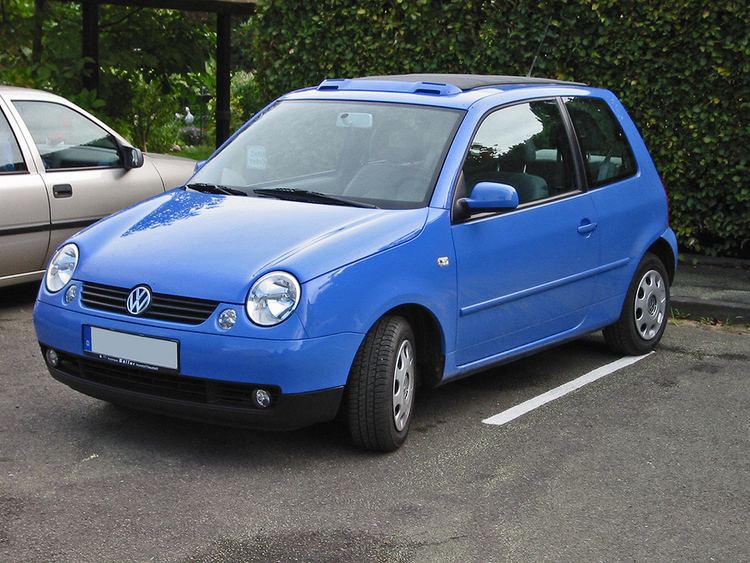Production 1998–2005 | Class City car (A) | |
 | ||
Assembly Wolfsburg, GermanyBrussels, Belgium | ||
The Volkswagen Lupo is a city car produced by the German car manufacturer Volkswagen from 1998 to 2005.
Contents
Model history
The Lupo was introduced in 1998 to fill a gap at the bottom of the Volkswagen model range caused by the increasing size and weight of the Polo. The 1998 Lupo was a badge-engineered version of the stablemate 1997 SEAT Arosa. Both use the A00 platform which is a shortened version of the Polo/Ibiza A0 platform. Initially only available in two trim variants, the budget E trim and the upgraded S trim; the range later expanded to include a Sport and GTI variant. Petrol engines ranged from 1.0 to 1.4 (1.6 for the GTI) with diesels from 1.2 to 1.7. The differences between the E and S trim included painted door mirrors, door handles and strip, central locking, electric windows, double folding seats and opening rear windows.
Production of the Lupo was discontinued in 2005, and was replaced by the Fox.
The Lupo name is Latin, meaning wolf, and is named after its home town of Wolfsburg.
Specifications
Lupo 3L
The Lupo 3L was a special-edition made with the intent of being the world's first car in series production consuming as little as 3 litres of fuel per 100 kilometres (78 miles per US gallon or 94 miles per Imperial gallon). To achieve this the 3L was significantly changed from the standard Lupo to include:
The 3L, along with the GTI and FSI, had a completely different steel body to other Lupos, using thinner but stronger steel sheet. The car had an automated electro-hydraulic manual transmission with a Tiptronic mode on the selector and an automated electro-hydraulic clutch. The car also had an ECO mode. When engaged it limited the power to 41 bhp (31 kW; 42 PS) (excluding kick down) and programmed the transmission to change up at the most economical point. ECO mode also activated the start/stop function, a feature that was new to European cars at the time. To restart, the driver simply takes his foot off the brake and presses the accelerator. In ECO mode, the clutch was disengaged when the accelerator pedal was released for maximum economy, so the car freewheels as much as possible, with the clutch re-engaging as soon as the accelerator pedal or brake pedal is touched. The 3L also has only 4 wheel bolts and alloy brake drums at the rear, along with many aluminum suspension components.
Initially, there were very few options on the 3L, as options added weight which affected fuel consumption. Those available initially were electrically heated and electrically controlled mirrors, fog lights and different paint colours. In order to increase sales, other options were offered including all-electric steering, electric windows and air conditioning. These options however, increased fuel consumption slightly. In 2001, a Japanese economy driver, Dr Miyano, used it to set a new world record for the most frugal circumnavigation of Britain in a standard diesel production car, with an average fuel economy figure of 119.48 mpg or 2.36 l/100 km. In November 2003, Gerhard Plattner covered a distance of 2,910 miles through 20 European countries in a standard Lupo 3L TDI. He achieved his aim of completing this journey - which started in Oslo, Norway and finished in The Hague in The Netherlands - with just 100 euros worth of fuel. In fact, all he required was 90.94 euros, which corresponds to an average consumption of 2.78 litres per 100 km (101.6 mpg).
According to the Lupo 3L instruction manual, the 3L engine also runs on Rapeseed Methyl Ester (RME) without any changes to the engine.
During the period of series production of the Lupo 3L, Volkswagen also presented the 1L Concept, a prototype made with the objective of proving the capability of producing a roadworthy vehicle consuming only 1 litre of fuel per 100 kilometres (235 miles per US gallon).
The Lupo 3L shared its engine and special gearbox with the Audi A2 1.2 TDI 3L. As a result of this and other changes, this Audi A2 is also capable of reaching the same results as the Lupo 3L.
Lupo FSi
The Lupo FSi was the first direct injection petrol powered production vehicle Volkswagen produced. A 5L/100 km 1.4 16v petrol version of the Lupo 3L with an average consumption of 4.9L/100 km. This direct injection engine next to a conventional engine with similar power uses around 30% less fuel. It had a similar automated gearbox to the 3L but with different gear ratios. Outwardly it was almost identical to a 3L but with a different front grill, slightly wider wheels with a different design and lacked the magnesium steering wheel and rear bumper of the 3L. The early 3L's and FSi's had aluminium tailgates which were lighter and more aerodynamic than their standard lupo counterparts, the early had FSi has a unique spoiler and the later ones without the aluminium tailgates were fitted with the same spoiler as the Lupo GTI. The FSi was only sold in Germany and Austria.
Lupo GTI
The 1.6 L Lupo GTI has been labelled a true successor to the Volkswagen Golf Mk1, one of the first true hot hatches. The GTI can be identified by its fully body-coloured bumpers and twin central exhausts. In 2002, a six-speed gearbox was added, together with improved throttle response, and was suggested as a competitor to the Mini Cooper or the larger Volkswagen Polo GTI. The GTI features much more standard equipment which was not available on any other in the Lupo range, including bi-xenon headlights, 15-inch Bathurst alloy wheels and an off black interior.
With a DOHC 16-valve four-cylinder engine producing 125 PS (123 hp), the GTI had a top speed of 127 mph (204 km/h) and could accelerate 0-60 mph in 7.8 seconds.
